Architecture: Interior of the Church
The church has undergone several renovations but strongly retains its Gothic character. In the 1920s an elaborate pattern was stenciled on the vaults and walls, featuring gold stars on a blue background. Frescoes of saints were also painted in the sanctuary. None of this decoration remains.
A major renovations of the interior of St. Francis Church took place in 1988-1989, when Father Gregory Dodge was pastor. A new altar, made of red oak, was placed in front of the older marble altar and reredos so that the celebrant could face the worshippers, an addition made in most Catholic churches following the liturgical changes resulting from the Second Vatican Council. A celebrant’s chair, facing the people, was added, and a former storage room was transformed into an adoration chapel. The most dramatic innovation was the construction of a baptismal pool at the front of the church. The ornate color scheme of the church was replaced by muted tones. Less-visible changes included the installation of central air conditioning and the structural reinforcement evident in the tie-rods spanning the vaults. During renovations over the years most of the significant pieces of art have been preserved, including the original stained glass windows, the sculpted Stations of the Cross, the marble and alabaster side altars with statues of the Blessed Virgin Mary and St. Joseph. The oak pews are original (but refinished in the renovation of 2023-2024).
It was not until 2023 that the parish undertook another renovation of the church interior. Father Matthias Lusembo led parishioners in fundraising and planning, with the guidance of the architect of the project, parishioner Matthew Fitzgerald. A photo slideshow of the renovation process is available on this website. The removal of the pews for refinishing and extensive painting of ceiling and walls necessitated the use of Assisi Hall for all liturgies during the construction. Notable changes included the addition of an altar rail, a new marble altar and lecterns, a dramatic canopy over the high altar, and an entirely new and more ornate color scheme for ceiling and walls. The large crucifix hanging over the sanctuary was repainted, and gold leaf was applied to it and to the soaring apse of the church.
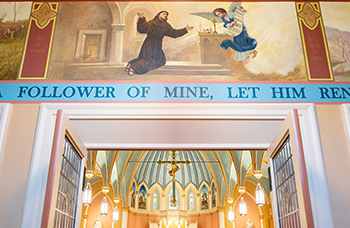
As one enters the church through the front (west) doors and passes into the narthex (or “vestibule”), a new mural depicting the life of St. Francis of Assisi, patron of the parish, can be seen (photo at right).
A second set of interior doors opens to the church proper. Once inside the nave (the section where worshippers sit), at the back of the church one can see two structures, both added during the most recent renovation and both crucial to the Catholic faith:
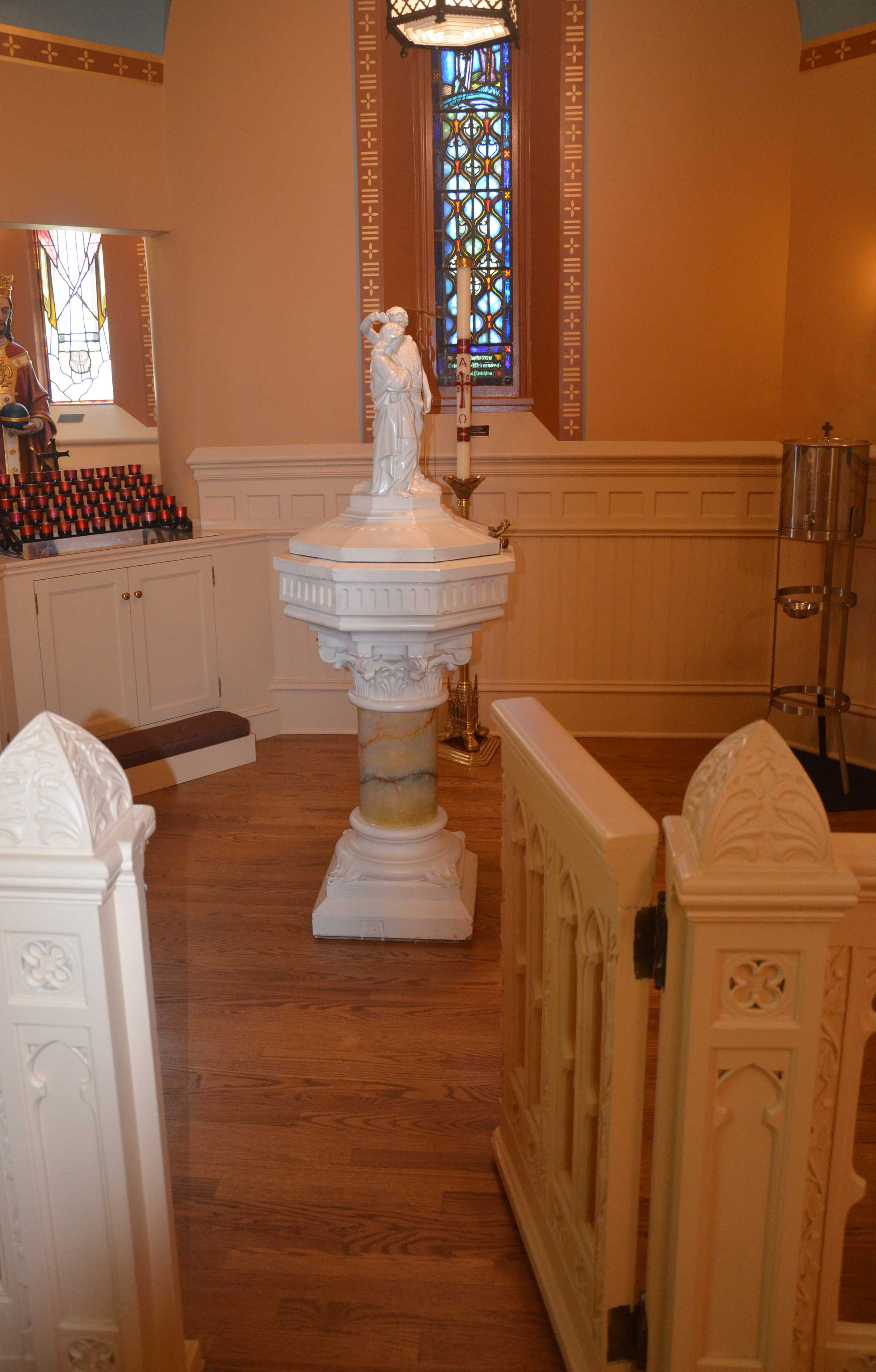 |
On the right side of the church is the baptistry (see photo), the space holding the font (which was added in the most recent renovation), where the sacrament of Baptism takes place. The font holds the water for Baptism, which makes one a Christian. Baptism, whether conferred on an infant or on an adult, washes away all sin, leads to a life with Christ as inspiration and guide, and makes all other sacraments possible. Even after baptism, however, a Christian may commit sin, and Christ has provided the sacrament of Reconciliation, in which a Christian confesses sin and receives the absolution conferred by Christ through the ministry of a priest. The confessional (see photo) was added during the 2023-2024 renovation. | 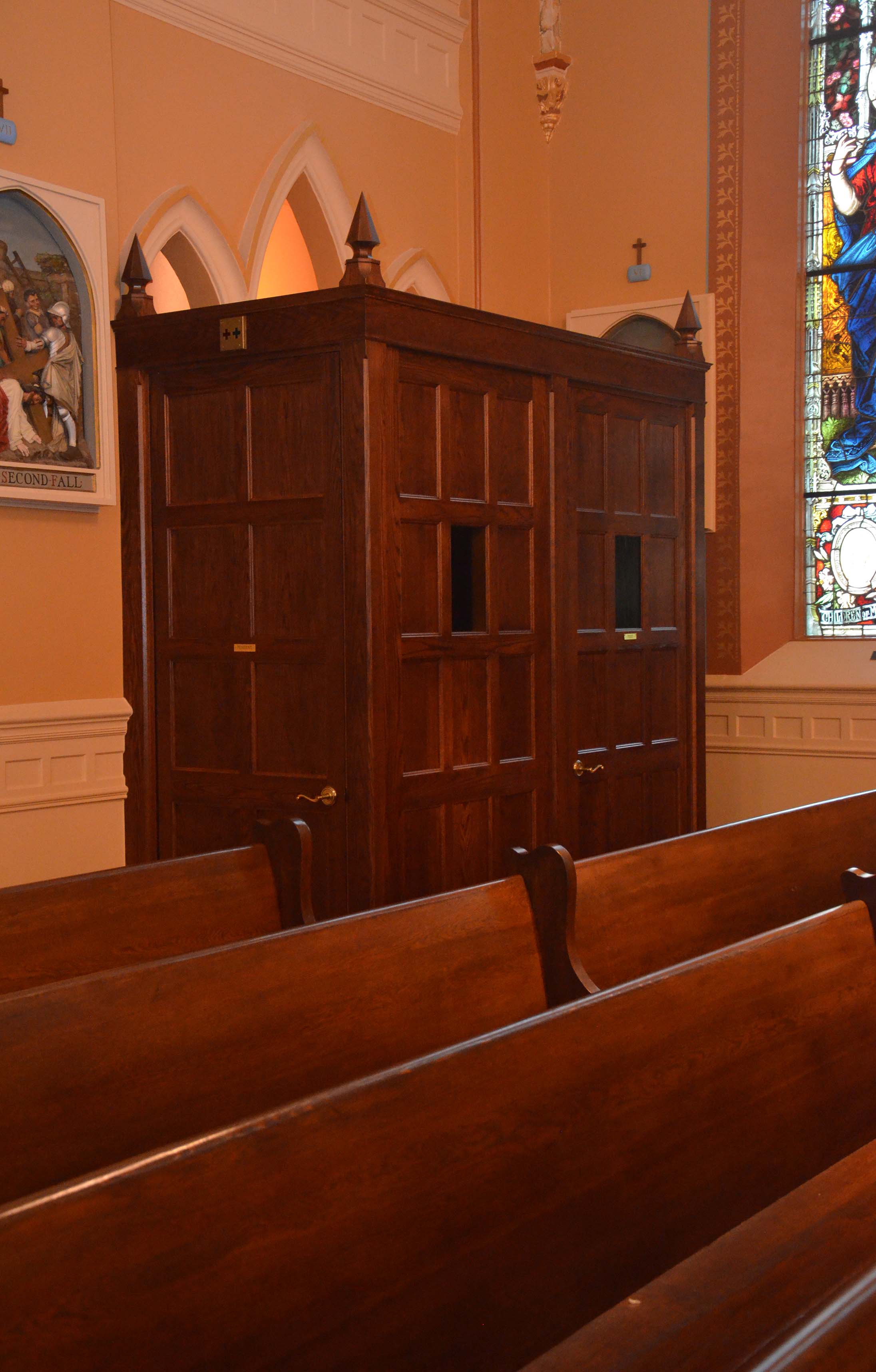 |
In the nave itself there is a central aisle which directs the beholder’s eyes along the central axis to the high reredos rising above the marble altar in the curved apse. Here the tabernacle of the Blessed Sacrament contains the Real Presence of Our Lord and Savior Jesus Christ, the “Bread of Life.” A pair of exquisitely carved marble kneeling angels stand on the sides of the altar; these sculptures were imported from Italy, probably in the nineteenth century.
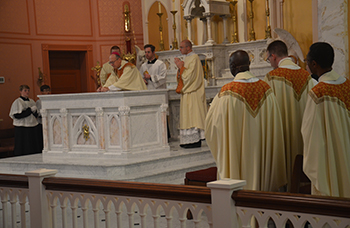
The central object of every Catholic church is the altar, on which is offered the sacrifice of the Mass. On Sunday, September 1, 2024, Bishop Barry Knestout of the Diocese of Richmond celebrated Mass for the Dedication of an Altar in a solemn ceremony that included sealing the relics of saints into the new altar and anointing it with consecrated chrism (see photo). A photo gallery of the ceremony can be found on this website.
Above the altar one can see, situated above the reredos, in a section called the apse, a triptych of small stained glass lancet windows. The church’s patron saint, St. Francis of Assisi (1181-1225), is honored in the center window and is flanked by the Sacred Heart of Jesus to his right and the Immaculate Heart of Mary to his left. Flanking the windows are paintings of the four evangelists (Matthew, Mark, Luke, and John). More detailed information on the apse can be found in the next section of this tour.
The side aisles of the nave are reflected in the ceiling in the two narrow rows of six ribbed vaults which flank the large central row of six vaults. The traditional columns which usually help support the vaults of the side aisles are missing in order to allow for more seating and an uninterrupted view of the altar.
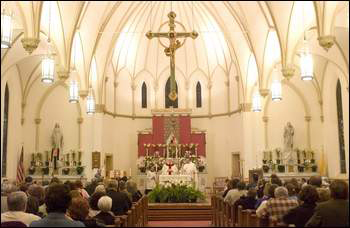 |
The photo at left shows the church before the 2023-2024 renovation; the photo on the right was taken afater the construction was completed. | 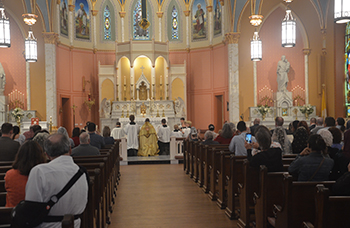 |
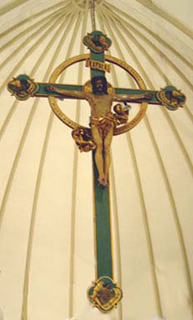
Perhaps the most dramatic feature of the church is the large crucifix hanging above the sanctuary (see photo at right, taken before the most recent renovation). More details about this cross are available in the next section of this tour, which deals with church furnishings.
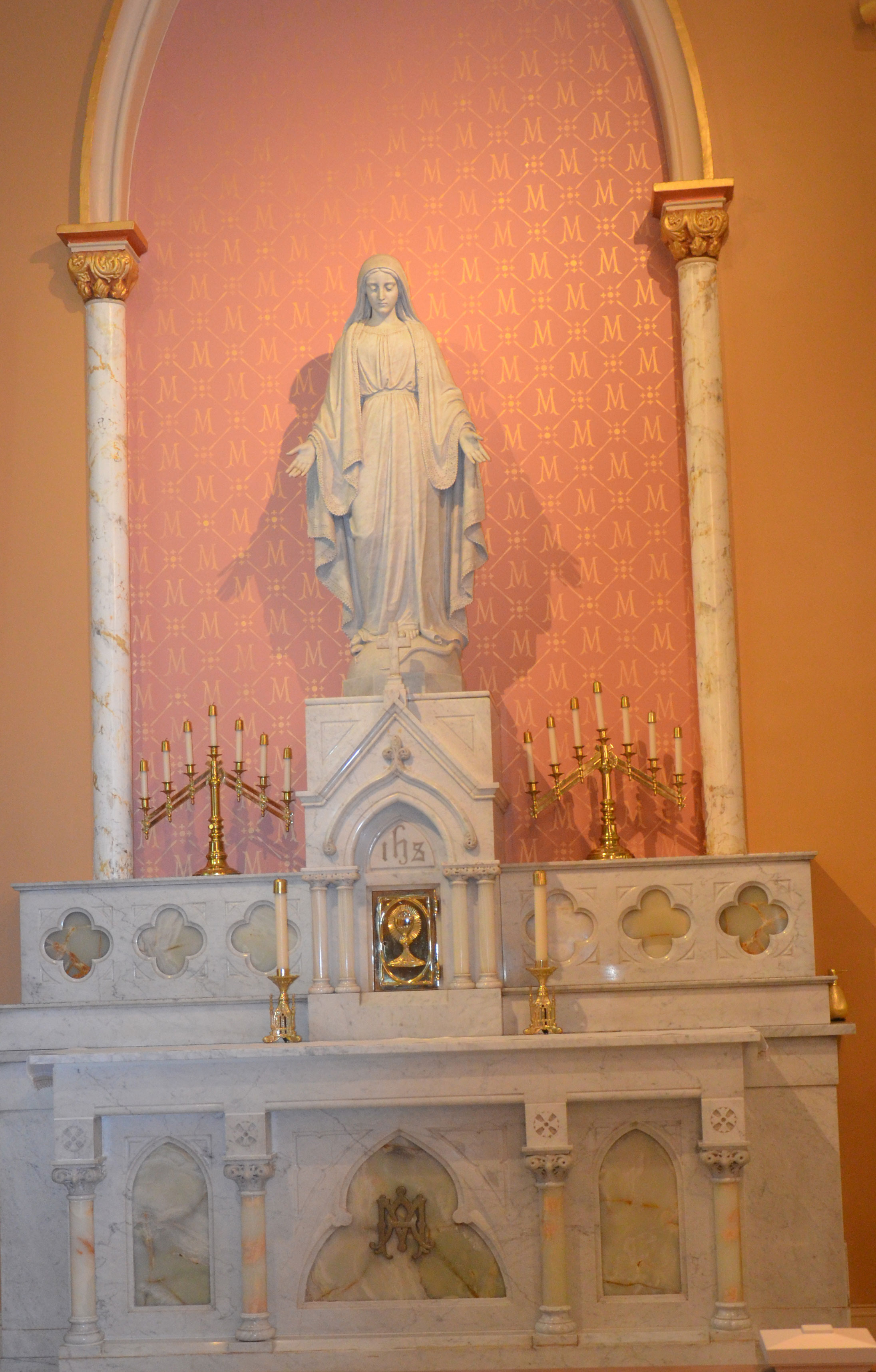 |
The auxiliary altars dedicated to the Blessed Virgin Mary (located on the left of the high altar, photo at left) and St. Joseph (on the opposite side of the nave) are readily accessible for private meditation. | 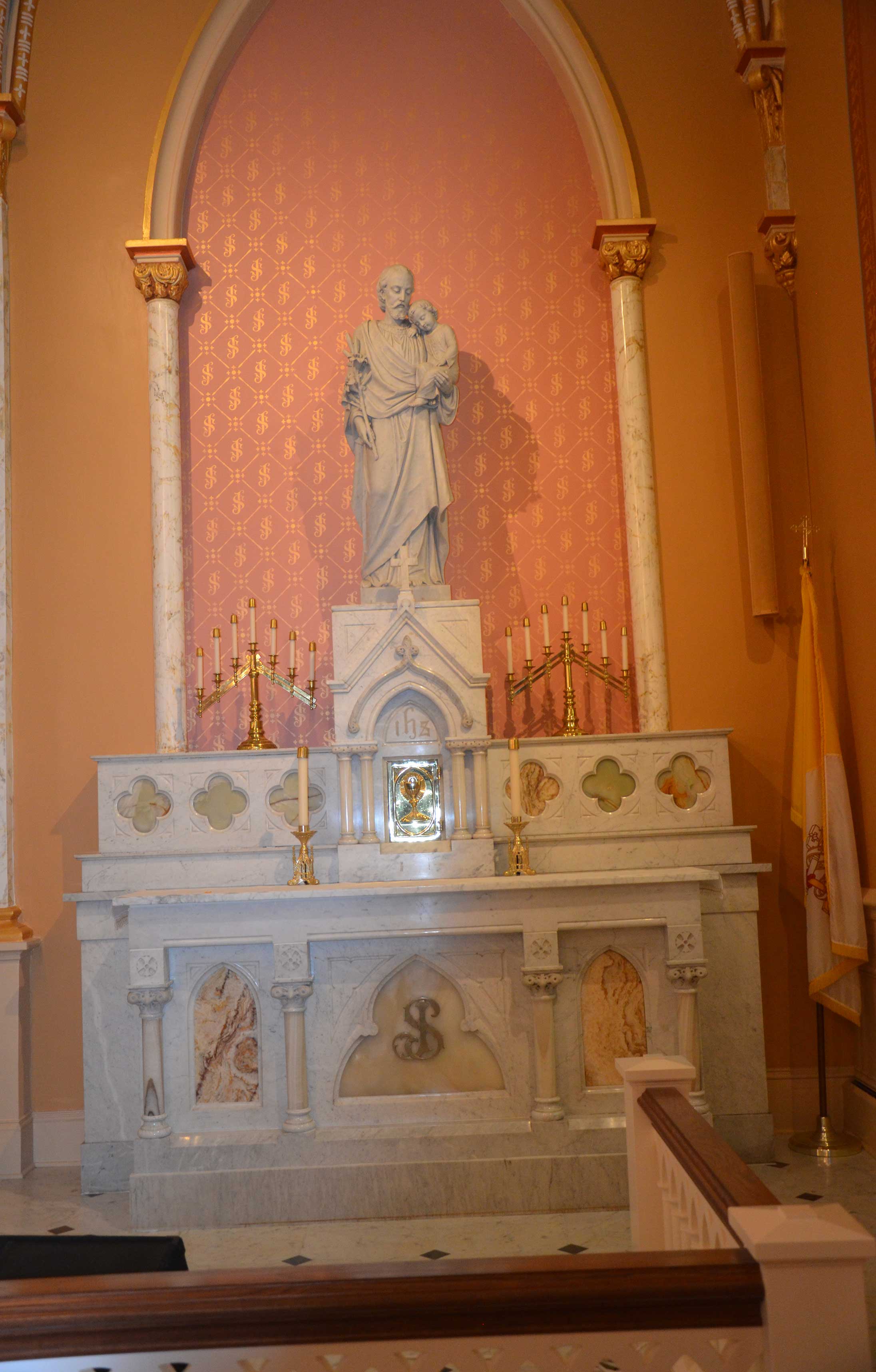
|
Additional features of the church building are described in the next section of this tour.
top of page